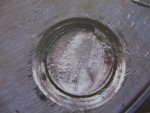-
Sign Up! To view all forums and unlock additional cool features
Welcome to the #1 Fiesta ST Forum and Fiesta ST community dedicated to Fiesta ST owners and enthusiasts. Register for an account, it's free and it's easy, so don't hesitate to join the Fiesta ST Forum today!
Keep breaking lugs - advice for hardened lugs??
- Thread starter maestromaestro
- Start date
Thread Starter
#42
Thread Starter
#42
You're points would be valid if there were 5 or even 100 samples. Were talking 10's of thousands. So get stronger studs and delay another breakage for another thousands of cycles. No fastner will withstand shearing loads or cyclic vibration . Cure the problem, not the symptoms .
As to your (not you're) "advice" to "cure the problem" - thanks, Captain. If you read my posts, you'd have realized that I had already ordered better rings. However, I am a fan of belt and suspenders approach.
Sent from my Pixel XL using Tapatalk
Last edited:
Here's an interesting article that might shed light on your problem. I thought the explanation of reverse bending fatigue and loss of clamping force to be of interest.
http://www.meaforensic.com/wheel-se...metallurgical-expert-mark-bailey-mea-forensic
http://www.meaforensic.com/wheel-se...metallurgical-expert-mark-bailey-mea-forensic
Thread Starter
#44
Thread Starter
#44
Here's an interesting article that might shed light on your problem. I thought the explanation of reverse bending fatigue and loss of clamping force to be of interest.
http://www.meaforensic.com/wheel-se...metallurgical-expert-mark-bailey-mea-forensic
http://www.meaforensic.com/wheel-se...metallurgical-expert-mark-bailey-mea-forensic
http://www.epi-eng.com/mechanical_engineering_basics/fatigue_in_metals.htm
Thread Starter
#46
Thread Starter
#46
The fatigue situations are common when there are vibrations, especially when high-frequency ones. To that end, if the part is secured by multiple fasteners, once one of them fails, it increases stresses on the adjacent ones and the whole thing snowballs. Hence the admonishment to check torque frequently; if anything, it would reveal the impacted studs/bolts. The torque for the FiST is high (e.g., a 911 requirement is 'only' 80 lb-ft) - so, a weakened stud will twist off (just like the one on my car).
In the picture above, you can see how the crack initiated and grew inwards and finally the bolt overloaded (ductile failure, the "lip" is visible at the 2 o'clock position). Discoloration shows that this took a bit of time to develop - maybe corrosion, maybe oxidation.
In the picture above, you can see how the crack initiated and grew inwards and finally the bolt overloaded (ductile failure, the "lip" is visible at the 2 o'clock position). Discoloration shows that this took a bit of time to develop - maybe corrosion, maybe oxidation.
I'd be curious to see if you still had these failures if you went back to the factory wheels. I know you've investigated this thoroughly and are convinced of a solution, but it sure sounds like you have a clamping failure leading to shear loads on the studs. Properly clamped, you should not be seeing shear loads. You wouldn't perhaps be spraying corrosion spray on the hub face?
Thread Starter
#48
Thread Starter
#48
I'd be curious to see if you still had these failure if you went back to the factory wheels. I know you've investigated this thoroughly and are convinced of a solution, but it sure sounds like you have a clamping failure leading to shear loads on the studs. Properly clamped, you should not be seeing shear loads.
Thread Starter
#50
Thread Starter
#50
Bolt torque is dictated by tensile strength (grade).
I think you touch on it before when you mentioned Root cause. What is the Root cause in this failure analysis?. Fix the root cause. There are plenty of guys running different rim/tyre combinations as well as wheel torque/horse power of plus 300.
I think you touch on it before when you mentioned Root cause. What is the Root cause in this failure analysis?. Fix the root cause. There are plenty of guys running different rim/tyre combinations as well as wheel torque/horse power of plus 300.
Ignorance and confusion alert: who's hub centric rings are flawed/cheap/dangerous and what is the actual torque listed for lug nuts on the FiST? I'm used to 68-80 lb ft. Thanks.
http://www.fordservicecontent.com/F...-ST-Supplement-version-1_st_EN-US_05_2015.pdf
(page 25)
Last edited:
Owners manual and service manuals both list wheel lug torque of 100 ft/lb...
http://www.fordservicecontent.com/F...-ST-Supplement-version-1_st_EN-US_05_2015.pdf
(page 25)
http://www.fordservicecontent.com/F...-ST-Supplement-version-1_st_EN-US_05_2015.pdf
(page 25)
That is just plain nuts - no pun intended.
When I tell them at the tire shop to use a torque wrench set to 40 ft/lbs they look at me like they want me to sign a waiver. LOL
I thought it high too, but it's their stuff... the red thing (see avatar) "book" is 40 ft/lbs.... That seems awfully low, but then the studs are only 3/8".
When I tell them at the tire shop to use a torque wrench set to 40 ft/lbs they look at me like they want me to sign a waiver. LOL
When I tell them at the tire shop to use a torque wrench set to 40 ft/lbs they look at me like they want me to sign a waiver. LOL
Similar threads
-
Euro Projectors - Low Beam Keeps Flickering Off and On
- Started by XanRules
- Replies: 0
-
-
-
Bro keeps dying while slowing down
- Started by GabzRK
- Replies: 8
-
After 5 days driving with Fiesta ST,car keeping pop problem to me,Alarm,fuel tank display
- Started by Zijian Wang
- Replies: 7
-
Fuse 24 (Emissions System) keeps blowing
- Started by Turbodhi
- Replies: 21
-
-
Fiesta st MBRP exhaust clamps keep loosening
- Started by Westley117
- Replies: 6
-
-
Coolant cap keeps breaking
- Started by FiestaSTdude
- Replies: 5

